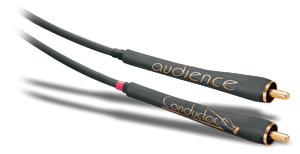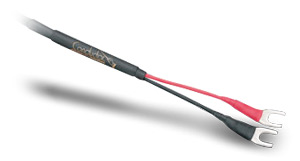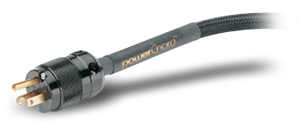Audience Conductor
Interconnects and Speaker Cables, powerChord AC Cords

Conductor interconnects
Conductor speaker cables

powerChord AC cord
|
Audience is a diverse company that manufacturers the
acclaimed Auricap capacitors, Auric Illuminator CD and DVD enhancer, and the just-released
adeptResponse power conditioner. They also perform modifications on Sony and Denon
optical-disc players to enhance their digital performance. In this review I look at
Audience’s affordable Conductor line of interconnects ($154 USD/1m pair) and speaker
cables ($320/3m pair), as well as their power cord, the aptly named powerChord
($449/6’).
Cable reviews
It’s difficult to come to grips with cables. The
obvious physical differences (e.g., in digital chips or capacitors) among source
components, speakers, and amplification devices can be correlated with perceived
differences in sound. Such differences aren’t always obvious with cables. They
don’t seem to do much of anything. Sure, cables transmit signals from source
to amp and from amp to speaker, but they have no buttons to press or cases to open, and
there’s not much to look at. But while different cables can indeed make audible
differences in a system’s sound, those effects are often subtle, and hard to describe
as "better" or "worse."
I hear differences with different cables, and some I prefer
more than others. But I don’t know why I hear the differences I do, nor do I
know whether you will hear similar differences. If you’re a cable skeptic, good for
you and your bank account. If you do hear differences between cables, then before you buy,
do yourself a favor and make sure you audition them with the equipment you’ll be
using with them.
I’d heard good things about Audience’s pricier
cables, the Au24 series, and looked forward to hearing how the Conductors stacked up --
I’d grown tired of the speaker cables I was using and wanted to try something new. If
the fact that I’d "grown tired" of cables doesn’t seem strange to you,
then you’re as hopelessly addicted to audio playback as I am. Most people don’t
even think about their speaker cables.
Auditioning the Conductors
When the Audience cables arrived, I spent a good deal of
time replacing all of the cables in my system. All of my Analysis Plus interconnects were
replaced with 1m Conductor interconnects, my Kimber Kable 4PR speaker cables were replaced
with Conductor speaker cables and jumpers, and everything with a removable power cord got
a new 6’ powerChord. (The cable lengths, of course, were determined by how my system
is set up; all of the Audience cables are available in other lengths.) My system included
a Rogue Audio Tempest integrated amplifier, Denon DVD-2900 universal audio/video player,
Rotel RT-02 AM/FM tuner, and Rotel RCD-1070 CD player.
I like the Audience cables’ appearance. Many
cables’ bright colors and awkward thicknesses seem designed to call attention to
themselves, but the understated Audiences are sleek, black, and flexible enough to be
easily snaked around corners and up and down cabinets. While I understand the desire to
make a colorful product, the discreet Audiences can blend into their surroundings much
more easily than many other designs -- important in listening rooms, such as mine, that
require longer-than-usual runs. The Conductors’ black, rubbery coating covers not
only the cable itself but the sides of the connector. Along the connector covering
you’ll find the only adornment: the tasteful Conductor logo and a black or red band
that identifies which half of the pair the cable is. The speaker cables look similar to
the interconnects but are slightly thicker.
I was at first skeptical about the benefits of a new power
cord, but my mind has been changed. If you’ve bought a CD player or amplifier for
several hundred dollars, you don’t immediately want to hear that things might be
better if you spend $449 more for an AC cord. But if you decide to, the powerChord is a
good option. Like the other Audience cables, the powerChord is flexible and well made. The
cord itself is about the diameter of a dime; it’s coated in a vinyl mesh and has a
large Marinco plug on one end and a Wattgate IEC socket on the other.
Usually, friends and family find the products that I review
-- and their prices -- to be otherworldly. I was pretty sure that my father, a practical
man, would find the idea of a $449 power cord absurd, and he did -- but he wasn’t so
dismissive of the job it might be doing. He runs power plants, and suggested that the
power coming in from the street might be infected with noise, particularly if the power
company allows Internet transmissions over their lines. (Thanks, Dad!) I’m convinced
that the powerChord played a role in the overall sound of my Audience-infected system, and
continued to do so when I began changing interconnects. It was a subtle role, however, and
none too obvious. Instruments seemed to appear more distinctly against blacker
backgrounds, I think because less noise was getting through to my system.
I had originally asked Audience for a pair of biwire
speaker cables to run to my Quad 21L speakers, but Audience favors using single speaker
cables and jumpers for biwirable speakers. Their jumpers share the same physical
characteristics of the speaker cables. Still, Audience supplied me with both a biwire pair
and a single pair with jumpers so that I could hear the difference for myself. For most of
my auditioning I used the single pair/jumper combination, and was very pleased. But the
biwire pair, too, sounded very good; I was hard-pressed to hear a significant difference.
Audience backs up their preference for single-wiring with some technical literature, and
the price difference is small: a 3m pair of Conductor speaker cables is $320, a pair of
jumpers $193; a pair of 3m biwire speaker cables is $449.
Sound
When I first sat down to listen, I was listening for
shortcomings, but none sprang immediately to ear. Playing the recent SACD reissue of Bill
Evans’ Portrait in Jazz [Riverside RISA-1162-6], there was no background noise
and the sound was very well balanced. The biggest problem I’ve noticed with
inexpensive interconnects is that the sound can suffer from a tinniness, but that was not
a problem here. Nor did I find the sound too bright or too dark. The piano sounded like a real
piano, which is not an easy thing to achieve. I kept trying to find things that were
lacking or exaggerated, but over time I found myself just enjoying the music.
After living with the Audience cables for several weeks, I
switched back to my Analysis Plus Solo Crystal Oval interconnects and Kimber 4PR speaker
cables. When I replaced the interconnects the sound became slightly brighter, but the
detail was noticeably better on such hard-to-reproduce sounds as cymbal crashes and
acoustic guitar. On the Evans SACD, the instruments’ physicality seemed to be
slightly more present. Remember, though, that with the Audiences I wasn’t consciously
able to pick this out as a problem -- I was happy with the Conductors. So, while in
almost-direct comparison I slightly preferred the Analysis Plus cables, which are more
than double the price at $399, the differences were marginal.
The Audience interconnects and speaker cables were pulling
their own weight and actively making a positive contribution to the sound of my system. I
find a lot of the terms used to describe cable performance to be meaningless; the best I
can do to sum up the differences I heard is that, with the Conductors, the sound was
closer to what I would expect from an analog source rather than the disc player I was
using: balanced, neutral, and smooth. Those, I think, are very good things.
When purchased in bulk, the Kimber 4PR costs less than $2
per foot; even including the cost of termination, it is much less expensive than the
Audience Conductor speaker cable. But the Audiences would be well worth the investment
based on their transparent but pleasing demeanor. Overall, the Audience cables made me
very happy with my system’s sound, and I was very pleased with their
price/performance ratio. I think you’ll be more than just satisfied with the Audience
Conductors; I think you’ll be happy.
Conclusion
Toward the beginning of this review I suggested that those
who are skeptical about the effects of interconnects and speaker cables are lucky, if for
no other reason than that it leaves them more time to devote to important things -- such
as music. The best way to do this, I think, is to find cables you like, buy ’em,
install ’em, and forget about ’em. The cables you choose should leave you with
no doubt that better performance can be had only at a far greater cost that would be out
of proportion with the cost of the rest of your system.
The Conductor cables from Audience fit this description
well. I can think of no good reason to spend more on cables for an affordably priced
system. While using the Audiences, I never once longed for more. The Conductor is the
affordable cable I’ll be recommending to friends and family.
The powerChord AC cord would be a more costly addition to
your system. If you’re happy with all of your source components, speakers, and
amplification, then it’s worth auditioning the powerChord to see how it might affect
your system’s sound. If your experience is anything like mine, you may very well end
up buying a few.
...Eric Hetherington
Prices of equipment reviewed
|